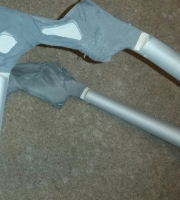

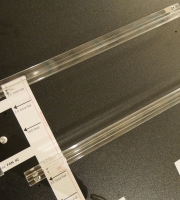
And here, the UFX sits merrily atop of it’s elder. In comparing the two, we can see that RME has chosen to eliminate the manual gains beside each Mic input on the UFX, whose input levels are now digitally adjusted using either the TotalMix software or master control knob.
Looking at the back of both units, aside from the discrepancies in socket layout, the UFX’s XLR type master outputs and AES/EBU digital I/O are notable upgrades though the option to add RME’s Time Code module (TCO) was and remains exclusive to the Fireface 800.
Having marveled so extensively at the hardware and aesthetics, let’s now turn our attention to RME’s no less redoubtable software and drivers.
The TotalMix user interface has represented the skeleton key to the acoustic treasures within RME’s creations from the very beginning. Anybody savoring it for the first time could be forgiven for feeling daunted, even a little frustrated by the somewhat unconventional design. But those who persevere are bound to conclude that it is as effective in achieving sound success as the hardware it controls. The multitude of innovative and practical features it harnesses are best conveyed in the UFX’s substantial 110 page manual, nevertheless, here are a few of the basics.
In examining a full view of the console (please click the image to enlarge), we can see there are three rows of faders and VU meters.
The top most of these, labeled “hardware inputs”, corresponds to audio that is routed into the UFX from external devices. The most important aspect to remember is that the faders on this row do not, as one might assume, adjust the level of the signal being received by the inputs, which instead, is set at one of three available reference levels, -10DBv, +4DBu or lo gain, the latter intended for professional equipment that is capable of the loudest output.
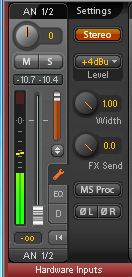
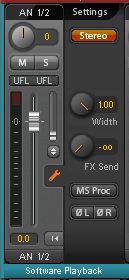
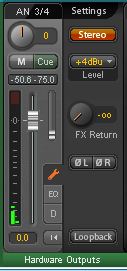
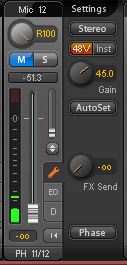
The four mic inputs (9, 10, 11 and 12), have additional controls for preamp gain – up to a maximum of 65db in 1db increments – phantom power and instrument/Hi-Z mode (the buttons marked 48v and “Inst”). If the “Autoset” button is pressed, the gain is continually reduced in accordance with the loudest signals so as to prevent distortion automatically, a handy function for live events or field work where setup time may be scarce.
So, what do the faders do? They control the level of the audio that is being sent (routed) to the UFX’s outputs. In the example shown above (far left), we are looking at inputs 1 and 2 (as indicated by “AN 1/2” at the top, just above the pan control knob). Underneath the fader “AN 1/2” is displayed again, though this time, it represents the outputs to which the audio is being routed, in our case 1 and 2. Thus, dragging the fader up will allow the signal that is being received by inputs 1 and 2 to be routed to outputs 1 and 2, with the fader controlling the level of the routed signal, not the input.
A similar rule applies to the second row of faders and VUs, which represent the UFX’s software playback channels. These faders determine the level at which the sound is played back, but that sound will only be audible through the output(s) to which it is being routed. In the above example (middle left), audio that is being played back on channels 1 and 2 (as denoted again by “AN 1/2” at the top) will be routed to outputs 1 and 2 (“AN 1/2” at the bottom), with the fader once more defining the volume of the routed signal. The third and final row of faders, labeled “hardware outputs”, is where all sound routed from the hardware inputs and software playback channels is directed. In the above example (middle right), the fader will adjust the volume of any audio that is being routed out of the UFX via outputs 3 and 4 (labeled “AN 3/4” in the console).
Once the user is able to commit these simple principals to memory, unlocking and exploiting TotalMix’s wealth of options quickly becomes a logical and greatly enjoyable process.